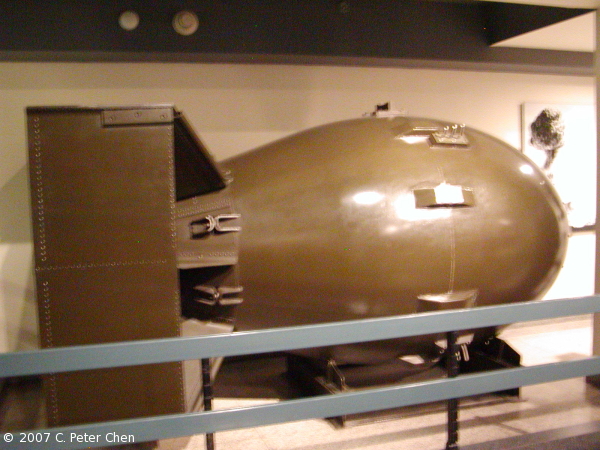
| Historical Information | |||||||||
| Caption | Model of the atomic bomb 'Fat Man' on display at the West Point Museum, United States Military Academy, West Point, New York, United States, 22 Sep 2007 ww2dbase | ||||||||
| Date | 22 Sep 2007 | ||||||||
| Photographer | C. Peter Chen | ||||||||
| Source Information | |||||||||
| Source | ww2dbaseC. Peter Chen | ||||||||
| Related Content | |||||||||
| More on... |
| ||||||||
| Photos on Same Day | 22 Sep 2007 | ||||||||
| Licensing Information | |||||||||
| Licensing | used with photographer's permission Please contact us regarding any inaccuracies with the above information. Thank you. |
||||||||
| Metadata | |||||||||
| Added By | C. Peter Chen | ||||||||
| Photo Size | 600 x 450 pixels | ||||||||
Você gostou deste artigo ou achou este artigo útil? Se sim, considere nos apoiar no Patreon. Qualquer valor já vai ajudar! Obrigado. Por favor, ajude-nos a divulgar o site: Fique atualizado com WW2DB: |
Visitor Submitted Comments
All visitor submitted comments are opinions of those making the submissions and do not reflect views of WW2DB.
Pesquisar WW2DB

Notícias
- » US State Lawmaker John Winter Caught Using Racial Slur "Jap" and Apologized (11 Jun 2025)
- » Köln/Cologne Evacuated After Discovery of WW2 Bombs (4 Jun 2025)
- » US Women's Army Corps "Six Triple Eight" Awarded with Congressional Gold Medal (30 Apr 2025)
- » Race, Holocaust, and African-American WW2 Histories Removed from the US Naval Academy Library (7 Apr 2025)
- » US Government Plans to Purge WW2 Information (17 Mar 2025)
- » Ver todas as notícias
Estatísticas Atuais do Site
- » 1,177 biografias
- » 337 eventos
- » 44,933 entradas na linha do tempo
- » 1,245 navios
- » 350 modelos de aeronaves
- » 207 modelos de veículos
- » 376 modelos de armas
- » 123 documentos históricos
- » 261 instalações
- » 470 eventos
- » 28,473 fotos
- » 365 mapas
Citação Famosa da 2ª GM
"We no longer demand anything, we want war."Joachim von Ribbentrop, German Foreign Minister, Aug 1939
Apoie-nos
Por favor, considere nos apoiar no Patreon. Mesmo R$1 por mês já faz uma grande diferença. Obrigado!
Ou, por favor, nos apoie adquirindo alguns produtos do WW2DB na TeeSpring. Obrigado!
27 Jan 2017 11:06:54 AM
TEAHOUSE OF THE AUGUST MOON:
THE JAPANESE BOMB
Wartime documents have surfaced, that the Japanese did have a program in the development of a nuclear device. Development started as early as 1937 scientists wanted both the Imperial Army & Navy to fund the project.
NOT A JOINT PROJECT: ONE AGAINST THE OTHER
Working separately the Army & Navy wanted there own bomb. However, with Japan's
early victories in the Pacific, the military didn't believe Japan would need the advantage of a nuclear bomb.
RETHINK THE BOMB:
As the war continued with less victories, the military started to change its mind, and showed its interest again in the project.
Japan lacked any uranium deposits, and relied on taking them by force from the occupied territories. Japan was able to get its hands on 5,000 tons of uranium oxide from Burma and had it shipped to Japan in 1943.
ARMY VS. NAVY:
The Imperial Navy set up its own nuclear program creating the "Nishina Project"
in 1943. The Navy F-GO project was different from the Army's NI-GO project with their use of uranium enrichment.
CLASSIFIED MATERIAL:
At the end of the war, both projects were classified by the US Government and held for decades after the end of World War II, tons of data and documents and related material were kept under great censorship. Did you know that the Japanese bought their Cyclotron in 1938 from UCLA University of California along with others bought later on.
These machines (Cyclotrons) were particle accelerators used in bombarding atoms, with such equipment aspects of nuclear reactions could be tested in the laboratory thus laying the theoretical ground work for atomic weapons...
DELIVERY SYSTEM:
The Germans shipped (12) twelve V-2 rocket to Japan before the collapse of the Third Reich. What became of the rockets is for conjecture and speculation.
The Japanese military lacked operational experience with such weapons and the time needed to bring such weapons on line would take months. However, the Japanese had experience in air-to ground missiles and other technology.
WARTIME DOCUMENTS: WHAT IF...
At wars end the US Armed Forces captured vast amounts of documents dealing with nuclear technology...from both Germany, Italy and Japan. We all know about the German and Italian effort in getting the bomb. But let's also assume that the Japanese were close, or did have such a weapon in the design stages, just maybe the two atomic bombs dropped on Hiroshima and Nagasaki put an end to the Japanese bomb, but I'm only guessing here.
Did you know that thousands of tons of wartime documents will be held in Government archives until 2045. What other secrets are still being held and what other mysteries that will come to light hundreds of years into the future...that have happened since the end of World War II...
DELIVERY SYSTEM: BOMBERS
The Japanese also lacked an operational four-engine bomber, to fly from Honshu, Japan to Los Angeles, California with enough range to strike at other American targets.
ON THE DRAWING BOARD:
Proposed Kawasaki Ki-91 four-engine bomber was set back, the factory planned to build the bomber was bombed by USAAF B-29's in February 1945.
Nakajima Ki-Gi0N1 a six- engine paper design bomber that was never built.
TEAHOUSE OF THE AUGUST MOON: Title came from a 1956 movie.
I thank the editor/ww2db for his continued support. My opinions, conclusions, freedom of expression, do not reflect ww2db in any way.